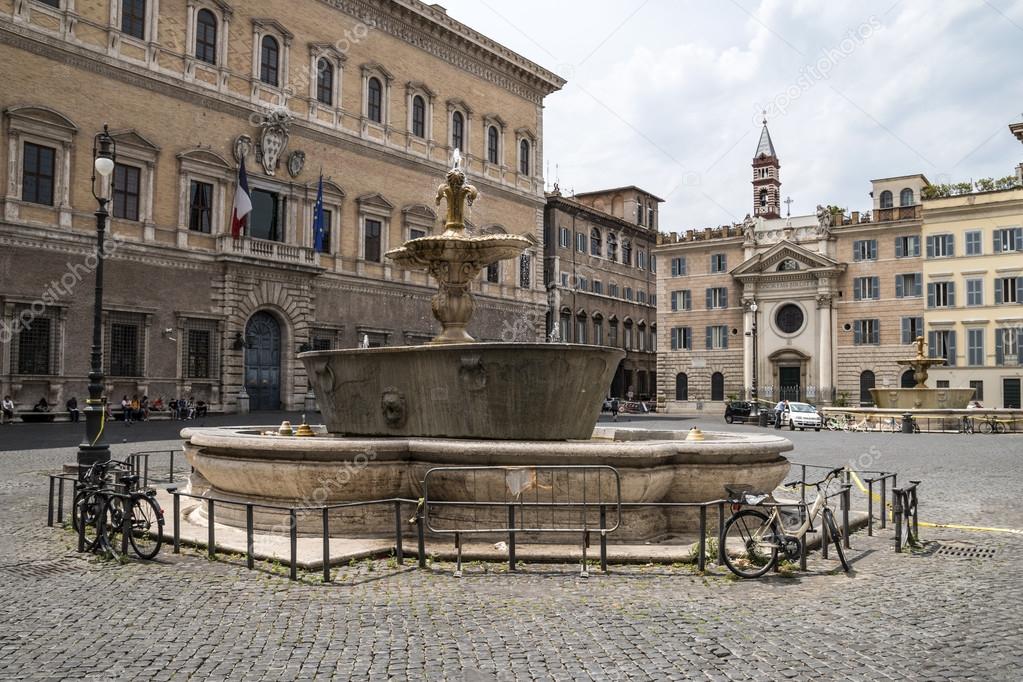Farnese Square

The square takes its name from the imposing Farnese Palace.
Farnese Palace

The Palace was built for Cardinal Alessandro Farnese by the greatest artists of the time.
Let’s talk about, Antonio da Sangallo Il Giovane, Michelangelo Buonarroti, Jacopo Barozzi called Vignola and Giacomo Della Porta.
The square began to be so named when the aforementioned Cardinal Farnese bought the houses of Cardinal Ferritz and others that he demolished, to make it a square where he built his splendid residence.
The palace was begun in 1514 on designs by Antonio da Sangallo Il Giovane.
Subsequently, both for the election of the cardinal as pontiff (Paul III) in 1534 and following the death of Sangallo (1546), the work was continued by Michelangelo.
Michelangelo, defined the layout of the first two floors,
he erected the third and embellished the façade with the central balcony and the splendid projecting cornice.
The material used for the construction of the palace was taken from the ruins of Ostia and those of the “Temple of the Sun”.
The travertine used was that from the quarries of Tivoli, while the beams for the ceilings of the palace, of exceptional proportions, were brought from the woods of Carnia.
It was nicknamed “the dice” for its square size, but it is also considered one of the four wonders of Rome.
In 1874 the French Embassy took up the palace through a lease with the Bourbons.

Purchased by France in 1911, the palace was resold to the Italian State in 1936, the year in which the two States signed an agreement to lease the two embassies,
the Italian one in Paris and the one French in Rome, for 99 years with emphyteutical rent.
The Fountains of Farnese Square

In the square there are also two beautiful fountains, consisting of two Egyptian granite tanks from the Baths of Caracalla.
In 1545 Paul III Farnese had one transported in front of his palace.
At the center of the then Del Duca Square (today Farnese), it was brought only for ornamental reasons as there was not enough water to feed the fountain.
In 1580 Cardinal Alessandro Farnese obtained permission from Pope Gregory XIII to take the second,
both still with a purely ornamental function.
It was Girolamo Rainaldi in 1626 who adapted them to fountains.
He attached them to the condes of the Acqua Paola, after Cardinal Odoardo Farnese obtained from Pope Gregory XV 40 ounces of water for the realization of the work.
The two pools are decorated with lion protomes and with relief rings and resting on as many travertine pools.
They have in the center two cups that support the Farnese lilies (originally in travertine, then redone in marble in the restoration work of 1938) from which gusps of water rise.
The square was long used as a space used for the organization of tournaments, bullfights and popular festivals.
Church of Santa Brigida in the heart of Farnese Square

On the right side of the square there is a building complex consisting of the church of Santa Brigida.
Del Gallo of Roccagiovine Palace

Another civil architecture that ennobles the square is Del Gallo of Roccagiovine Palace, today home to a lucky few.
What makes this palace unique is the magnificent staircase in the courtyard.

Farnese Square together with Campo Dé Fiori Square, both adjacent, are considered as favorite destinations for Romans and tourists for a walk.
Rich in clubs and restaurants, they are the best choice to spend an evening full of fun admiring, between a glass of wine and a plate of pasta, the history that characterizes them.

